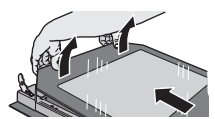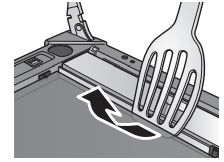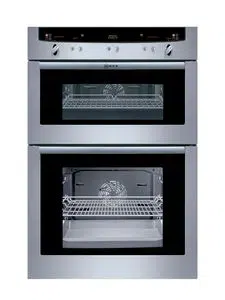Documents: Go to download!
- Owner's manual - (English)
- Your new cooker
- Before using your appliance for the first time
- Electronic clock
- Oven operating modes
- Operating the oven Main and mini oven
- Baking
- Roasting
- Grilling
- Surface grilling
- Defrosting and cooking
- Steam cooking – only the main oven
- Dough proving – only the main oven
- Cleaning and Care
- Trouble-shooting Guide
Table of contents
Owners' Guide Ovens
Your new cooker
Here you will learn more about your new oven. The control panel and its switches and indicators are explained here. The heating modes and the accessories included with your oven will be explained here.
The control panel

Oven operating modes
 Hot air functions
Hot air functions
Circotherm
Defrost
Circotherm intensive
Bread baking
 Grill functions
Grill functions
Large area grill
See other models: U1320N2GB/05 I99C68N1/01 D64AFM1N0B N17HH10N0B D57ML67N0B/03
Small area grill
Circo-roasting
 Conventional functions
Conventional functions
Top/bottom heat
Bottom heat
 Special functions
Special functions
Steam cooking, for system steam cooker (option available from specialist dealers)
Dough proving
Oven cleaning
Light
Note
The oven light switches on for every oven function.
Rapid heating  can be selected for circotherm or bread baking.
can be selected for circotherm or bread baking.
Press-down switches
To engage and disengage, depress the switch, making sure that it is in OFF position.
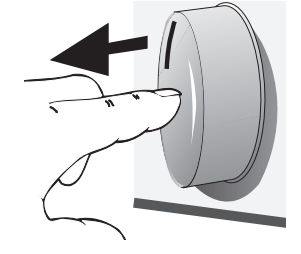
Shelf position
Mini oven
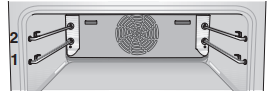
Your oven features 2 shelf positions.
The shelf positions are counted from bottom to top.
The numbers are marked in the oven.
Main oven

Your oven features 4 shelf position. The shelf position are counted from bottom to top. The numbers are marked in the oven.
When using hot air functions  , do not use shelf position »2«, in order not to block air circulation.
, do not use shelf position »2«, in order not to block air circulation.
The shelf supports and telescopic rails can be inserted at your preferred shelf position.
The simple plug-in system provides you with flexible and quick handling when changing the shelf supports and telescopic rails.
Before using your appliance for the first time
Language for the text display
You can choose one of seven languages for the the display text.
Change language
The default setting for the display text is German. There are various languages you can choose from.
Example: main oven
Change standard setting

The function selector must be switched OFF.
- Keep the rapid heating
 button pressed until Language English appears on the text display
button pressed until Language English appears on the text display - Turn the temperature selector until the language you want appears. This language is activated after three seconds.
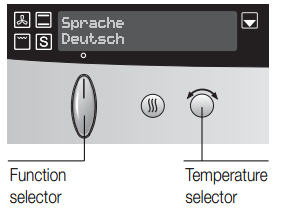
Preliminary cleaning
Take the accessories out of the oven.
Remove all packaging remnants, e.g. polystyrene parts, from the oven.
- Clean the appliance exterior with a soft moistened cloth.
- Remove the shelf supports and telescopic rails from the oven.
- Clean the oven and the accessories with a hot detergent solution.
Please observe the operating instructions furnished with the hob.
Initial burn-in
Before using the appliance for the first time, you must set the time on the electronic clock.
Heat the empty oven for approx. 30 minutes. Select top and bottom heat at a setting of 240° C.
Subsequent cleaning
Clean the oven with a hot detergent solution. Install the shelf supports and telescopic rails.
Time of day
Setting the time
After connecting to the mains, or after a power failure, the display 0:00 will blink.
Press the  button and set the current time with the rotary knob (e.g. 15:00 hours).
button and set the current time with the rotary knob (e.g. 15:00 hours).
To correct the time, press the  button until the symbol flashes. Then set the time.
button until the symbol flashes. Then set the time.
Note: The time cannot be corrected if an automatic function or the timer has been set (to cancel see ”Electronic clock”).
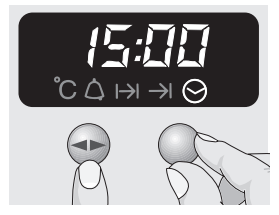
Electronic clock
The electronic clock can be operated with one hand; after pressing the button, set the time with the rotary knob. Settings can be made for as long as the function display flashes (~4 seconds).
The control panel

Note
The current oven temperature is displayed only when the temperature is checked.
Clock functions
Minute timer  |
Counts down minutes (max. 24 h). |
Set cooking time  |
Switches off automatically. You set an cooking time for the current operating mode (max. 6 h) after which the appliance switches off automatically. |
Time preselection  |
Switches on and off automatically. You specify when the oven switches on automatically and after how long it switches off again (max. 24 h). |
Time of day  |
To change the current time of day or reset following a power failure. |
| Delete times | Delete time settings: Minute timer, Set cooking timer and Timer preselection. |
Time of day
Setting the time
After connecting to the mains, or after a power failure, the display 0:00 will blink.
Press the  button and set the current time with the rotary knob (e.g. 15:00 hours).
button and set the current time with the rotary knob (e.g. 15:00 hours).
To correct the time, press the  button until the symbol flashes. Then set the time.
button until the symbol flashes. Then set the time.
Note: The time cannot be corrected if an automatic function or the timer has been set (to cancel see ”Electronic clock”).
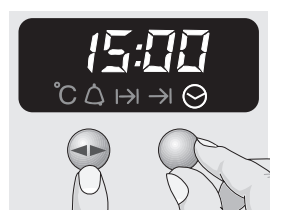
Minute timer
- Press the
 symbol flashes, and set the time you want
symbol flashes, and set the time you want  button until the, (e.g. 5 minutes). When the timer switches on, the remaining time is displayed.
button until the, (e.g. 5 minutes). When the timer switches on, the remaining time is displayed. - When the time has elapsed, a signal is emitted and the
 symbol flashes. To stop the signal, press the
symbol flashes. To stop the signal, press the  button.
button.
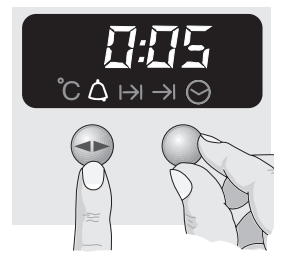
Automatic timer – main oven
You can switch the oven on and off via the electronic clock.
The most suitable dishes for automatic timing are those which require little attention.
Set cooking time
Automatic switch off
If you wish to bake or roast food immediately, it is only necessary to set the cooking time.
- Select the operating mode and the oven temperature.
- Press the
 button until the
button until the  symbol flashes and set the cooking time with the rotary knob (example: 1 hour and 30 minutes). When the setting has been made, the current time is displayed after approx. 4 seconds. The
symbol flashes and set the cooking time with the rotary knob (example: 1 hour and 30 minutes). When the setting has been made, the current time is displayed after approx. 4 seconds. The  symbol signals automatic mode.
symbol signals automatic mode. - When the time has elapsed (example: 1 hour and 30 minutes), a signal is emitted and the
 display flashes. The oven switches off automatically. To stop the signal, press the
display flashes. The oven switches off automatically. To stop the signal, press the  button.
button. - Switch the oven off.
- To end automatic mode, press the
 button again.
button again.

Time preselection Automatic switch on and switch off
If the food is to be baked or roasted later on, both the cooking time and OFF time must be set.
- Select the operating mode and the oven temperature.
- Press the
 button until the
button until the  symbol flashes and set the cooking time with the rotary knob (example: 1 hour and 30 minutes).
symbol flashes and set the cooking time with the rotary knob (example: 1 hour and 30 minutes). - Press the
 button until the
button until the  symbol flashes and set the OFF time with the rotary knob (example: 12:30). When the setting has been made, the current time is displayed after approx. 4 seconds. The
symbol flashes and set the OFF time with the rotary knob (example: 12:30). When the setting has been made, the current time is displayed after approx. 4 seconds. The  symbol signals automatic mode.
symbol signals automatic mode.
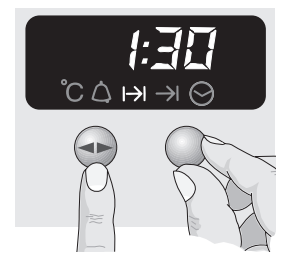
- The oven is automatically switched on and off at the preset times (e.g. 11:00 and 12:30).
- When the time has elapsed, a signal is emitted and the
 symbol flashes. To stop the signal, press the
symbol flashes. To stop the signal, press the  button.
button. - Switch the oven off.
- To end automatic mode, press the
 button.
button.
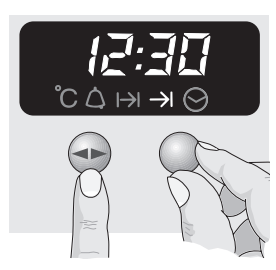
Checking, correcting and cancelling settings
- To check your settings, press the
 button until the symbol flashes.
button until the symbol flashes. - If required, correct the settings with the rotary knob.
- If you want to cancel your settings, turn the set time back to 0:00 and switch the oven off.
Note
The minute timer and OFF time can be preprogrammed up to a max. 24 hours. The settings can be displayed at any time by pressing the  button.
button.
Special functions
Masking out the display
- Press the
 button for 7 seconds. After this time the display dims, the time and the display continue running in the background.
button for 7 seconds. After this time the display dims, the time and the display continue running in the background. - To switch on the display, briefly press the
 button.
button.
Dimming the display
Between 22.00 and 6.00 the display is automatically dimmed.
Oven operating modes
Here you will receive an overview of the four oven functions: hot air functions, conventional functions, grill functions and special functions. The oven functions are divided into the following operating modes.
Hot air functions 
The hot air functions include:
Circotherm
A fan system located in the rear oven wall circulates the circotherm in the oven, achieving an especially effective heat transfer to the food being baked or roasted.
Advantages:
– Simultaneous baking and roasting is possible in the main oven on up to 3 shelf positions
– Baking and roasting is possible in the mini oven on one shelf position only
– low soiling of oven interior
– shorter preheating times
– low oven temperatures
– gentle defrosting, see the Defrosting and cooking section for adjusting the ”defrost” setting.
Circotherm intensive
The Circotherm intensive adds the bottom heat to the circotherm.
Advantages:
– Fresh preparation of food with wet fillings or toppings, e.g. pizza and flan.
– Especially suited for frozen products, e.g. pizzas, chips etc.
Bread baking
Bread baking with hot air function. Adjustable 180 – 220° C.
Note
Rapid heat up Can be selected for Circotherm or bread baking setting.
Conventional functions 
The conventional functions include:
Top/bottom heat (Conventional heating system)
The food being baked or roasted is exposed to heat radiation from heating elements located at the top and bottom of the oven cavity.
Baking and roasting is possible on one shelf position only.
Advantages:
– Baking of cake with wet fillings, pizza, quiche, e.g.
Bottom heat
With this setting, only the heating element at the bottom of the oven cavity is activated.
Advantage:
– Particularly useful with dishes and baked goods that require a distinctive bottom crust or browning.
Use just before the end of the baking or roasting time.
Grill functions 
The grill functions include:
Large area grill The food being prepared is exposed to heat radiation from the heating element at the top of the oven cavity.
Advantages:
– Particularly effective with flat, small cuts of meat, i.e., steaks, sausages, fish, vegetables and toast.
– the entire grilling surface heats up
– especially useful with large amounts of food.
Small area grill
Advantages:
– only the centre area of the grilling surface heats up
– especially useful with small amounts of food – energy-saving operation.
Circo-roasting
With circo-roasting, the air circulating fan and the grilling elements are activated alternataly.
The heat generated by the grilling element is evenly distributed in the oven cavity.
Advantage:
– Particularly effective with poultry
Special functions 
The special functions include:
Steam cooking– main oven
For system steam cooker (option available from specialist dealers)
Dough proving – main oven
The dough proving function provides ideal conditions inside the oven for getting yeast dough to rise. Temperature: 35 – 38° C Humidity: 75 – 100%
Advantages:
– rapid and uniform increase in volume of dough
– dough does not dry out
– dough does not form a skin which means that it very easy to process and work into the required shape
– exclusion of unfavourable external influences (e.g. draughts).
– yoghurt can be made.
Oven Cleaning
Oven cleaning is a regeneration programme. If the self-cleaning panels in the oven are no longer adequately cleaned during normal day-to-day operation, they will be regenerated with this function. They will then be fully functional again.
Light
The oven light is switched on. After 30 minutes the light automatically switches off again. The oven does not heat up.
Operating the oven
Main and mini oven
Switching the oven ON
Example: Circotherm – main oven

Before you switch on your oven, decide which operating mode you would like to use.
Rotate the function selector to the right until the required operating mode lights up on the text display.
The suggested temperature is displayed and the oven light switches on.
Changing the temperature
You can increase or reduce the suggested temperature with the temperature selector in steps of 5° C.
Notes Steam cooking, dough proving and oven cleaning. ➝ The temperature is fixed and cannot be changed.
Indicator light
The  on the temperature display is backlit when the oven is heating up or a new temperature is selected.
on the temperature display is backlit when the oven is heating up or a new temperature is selected.
Rapid heat up
Switching on
You can switch on rapid heat up for Circotherm hot air and bread baking setting.
Press the  button. Rapid heat up is displayed.
button. Rapid heat up is displayed.
Cancelling
Press the  button to switch OFF rapid heating. Rapid heat up disappears from the display.
button to switch OFF rapid heating. Rapid heat up disappears from the display.
Current oven temperature – main oven
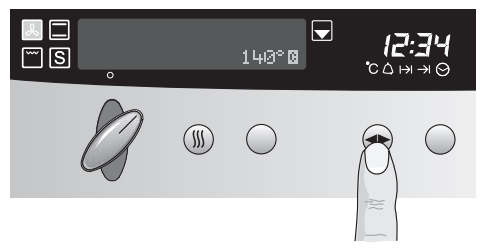
When the oven is heating up, the temperature in the oven can be displayed for about five seconds. Press the  button. This does not apply to steam cooking, dough proving, oven lighting and defrosting modes.
button. This does not apply to steam cooking, dough proving, oven lighting and defrosting modes.
Switching the oven OFF
Turn the function selector to the 0 position. All functions are deleted.
When the oven has been switched off, the fan may continue running for a short time to cool the oven.
Residual heat display for the oven
The current temperature range is indicated on thetext display:
Residual heat high above 120°C
Residual heat low 60 – 120°C.
Temperature ranges of the various heating systems
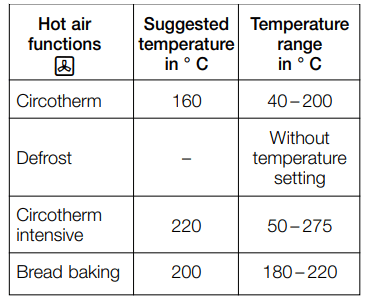
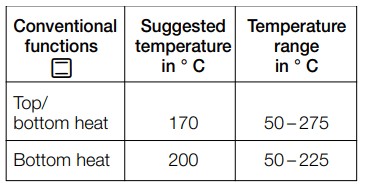
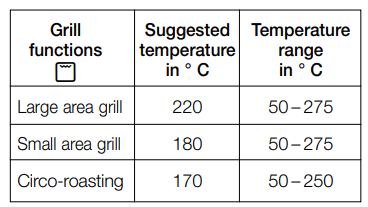
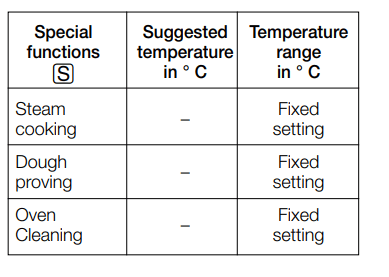
Baking
Using baking tins

Always place baking tins in the centre of the baking wire shelf.
We recommend dark metallic baking tins.
Notes
Light coloured baking tins made from thin-wall materials lead to longer baking times and uneven browning of the cake.
You can influence the degree of browning by changing the temperature setting.
If a cake collapses after removing it from the oven, consider using a longer baking time, or use a slightly lower temperature setting.
Using tinplate baking tins
 Circotherm Shelf position 1
Circotherm Shelf position 1
 Top/bottom heat Shelf position 1
Top/bottom heat Shelf position 1
If the cake bottom gets too dark:
Check the shelf position. Shorten the baking time, and possibly use a lower baking temperature.
If the cake bottom stays too light:
Check the shelf position. Increase the baking time, select a lower temperature, or use a dark metal baking tin.
Do not place baking forms or high cakes too close to the rear oven wall.
Cooking Tips and Helpful Hints
| The bottom of a cake baked on a baking tray stays too light | Remove from the oven all baking tray or universal pan currently not in use. |
| The bottom of a cake baked in a tin stays too light | Use a wire shelf and not a baking tray to support the cake tin during baking. |
| The bottom of cake or cookies gets too dark | Set cake or cookies into a higher set of shelf position. |
| The cake gets too dry | Select a slightly higher oven temperature, and shorter baking time. |
| The cake is too moist on the inside |
Choose a slightly lower baking temperature. Note: Higher temperatures do not shorten baking times (done on the outside, raw on the inside). Choose a slightly longer baking time, allow the dough to rise slightly longer. Add less liquid to the dough. |
| When baked with circotherm, cake baked in round or square tins gets too dark at the rear | Avoid blocking the air vents at the rear wall of the oven cavity with the cake tins. |
| Very moist cake dough (e.g. fruit cake) causes a lot of steam to generate in the oven that condenses on the oven door | You can let the steam escape from the oven andthereby reduce the forming of water droplets by briefly and carefully opening the oven door (once or twice, in case of longer baking times more often). |
| Very uneven browning when using circotherm circulation | Check the shelf position. |
| Cake collapses when taken out of the oven | Use less liquid |
| To save energy |
Preheat only if expressly required by the recipe. Dark baking tins have a higher degree of heat absorption. Residual heat: In the case of longer baking times, you can switch off the oven 5-10 minutes before the full baking time has elapsed. |
Roasting

Place the wire shelf in the universal pan and slide both into the oven at the same shelf position. Meat can be roasted in the oven in a particularly economical fashion if the weight of the cut exceeds 750 grams.
Roasting in an uncovered pot
Rinse the universal pan and/or the roaster with water, and place the meat into it.
With fat meat and poultry, pour 125 to 250 ml of water (to suit the size and kind of roast) into the universal pan. At your discretion, baste lean meat with fat, or cover it with bacon strips.
The roast drippings collecting in the universal pan make a tasty gravy. Dissolve the drippings with hot water, bring to a boil, thicken with corn starch, season to taste and, if required, pass it through a strainer.
No preheating is required. Save energy by putting the roast into the oven while it is still cold.
Roasting in a covered pot
Place the meat into the roasting pot (or Dutch oven), cover it with a matching lid, and place it on the wire shelf in the oven. We recommend that beef roast be prepared in a covered roasting pot.
Tips
Big, high roasts, goose, turkey, duck
= Long roasting times, low temperatures Medium sized, low roasts
= Medium roasting times, medium temperatures Small, flat roasts
= Short roasting times, high temperatures
Roasting time per cm of meat height without bones app. 13-15 minutes Roasting time per cm of meat height with bones app. 15-18 minutes
We recommend using the lower of the stated temperatures first. In general, the lower temperature ensures a more even browning.
We recommend turning the roast after half or two thirds of the roasting time have elapsed when using the setting  .
.
For roasting, use only cookware with oven-proof handles.
Prepare large roast directly in the universal pan, without using the wire shelf.
Smaller cuts of meat can be roasted on aluminium foil. To do so, bend the edges of the foil upward, as if to form a dish, and place it on the wire shelf.
After the end of the selected roasting time and with the oven switched OFF, leave the roast in the closed oven for approx. 10 minutes.
The roast is not done on the inside
Use a lower roasting temperature.
Note: Higher temperatures do not shorten roasting times (done on the outside, raw on the inside). Choose slightly longer roasting times.
Very moist roasts (e.g. roasts prepared with water) cause a lot of steam to generate in the oven that condenses on the oven door.
You can let the steam escape from the oven and thereby reduce the forming of water droplets by briefly and carefully opening the oven door (once or twice, in case of longer roasting times more often).
Grilling
Notes on grilling
Exercise CAUTION when grilling. Always keep children at a safe distance.
Always close the oven door when grilling.
The grilling temperatures are variable.
Always use the wire shelf and the universal pan.
Always place food to be grilled in the centre of the wire shelf.
If the grill element (heating element) switches OFF automatically, the overheating protection was activated.
The radiator will be reactivated after a short period of time.
Place the wire shelf into the universal pan and slide them together into the same shelf position.
Circo-roasting
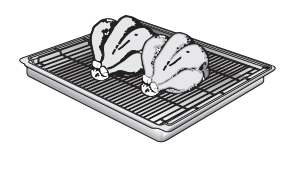
Use this method for particularly crispy poultry or roast (e.g., pork roast with crackling).
Use the wire shelf and universal pan together. Turn large roasts after about half of the total grilling time has elapsed.
To prevent breakage after removing them from the oven, place glass utensils on a dry kitchen towel instead of cold or wet surfaces.
Dependent on the type of food being prepared, combination hot-air and surface grilling can cause an increased degree of oven soiling. Therefore, to prevent burning-in of the soil, thorough cleaning of the oven is recommended after each use.
Whole poultry should be turned after approx. two-thirds of the cooking time has elapsed. With duck and goose, pierce the skin under the wings to allow excess fat to drain off.
After the end of the selected roasting time and with the oven switched OFF, leave the roast in the closed oven for approx. 10 minutes.
Surface grilling
Large area grill

Small area grill
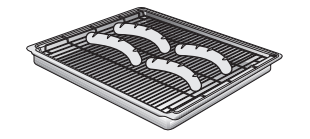
Used for smaller dishes having little height/thickness.
Always use the wire shelf and universal pan together.
Turn the food after approx. two-thirds of the grilling time has elapsed.
At your discretion, lightly baste the wire shelf and the food with oil.
Defrosting and cooking
Defrosting with Circotherm
Important heating system information
For defrosting and cooking of frozen or deep frozen foods, use only the circotherm heating system.
With all deep-frozen foods, follow the food processing company‘s instructions on the package.
As a rule, defrosted frozen or deep-frozen foods (especially meats) require less cooking time than fresh products, since freezing has a pre-cooking effect.
If frozen meat is placed in the oven, the defrosting time must be added to the required cooking time. Always defrost deep-frozen poultry before cooking because the giblets must be removed. For cooking deep-frozen fish, use the same temperatures as for fresh fish. Deep-frozen ready-to-eat meals in aluminium dishes may be placed into the oven several at a time.
Shelf position
With 1 baking sheet: Shelf position 1
With 2 baking sheets: Shelf position 1 + 3 for the main oven.
All stated times are approximate guidelines that vary with the shape and volume of deep-frozen products.
Defrosting and cooking
Raw deep-frozen products or foods from a freezer always defrost at 50° C. Higher defrosting temperatures may cause the food to dry out.
Defrost deep-frozen meals packed in aluminium foil or closed aluminium containers at a setting of 130 – 140° C.
Defrost and warm up deep-frozen baked goods at 100 – 140° C. Brush bread, rolls or yeast pastry lightly with water to make the crust more appealing.
Defrost dry deep-frozen yeast cakes at 160 – 170° C for 20 – 30 minutes.
Defrost moist deep-frozen yeast cakes (with fruit topping) at 160 – 170° C for 30 – 50 minutes after wrapping in aluminium foil to prevent cake from drying out.
Defrost and toast deep-frozen toast (with topping) at 160 – 170° C for about 20 minutes.
Frozen pizza: Please follow the manufacturers’ instructions.
Defrost setting
Recommended for delicate bakeware only (i.e., whipped-cream gateaus).
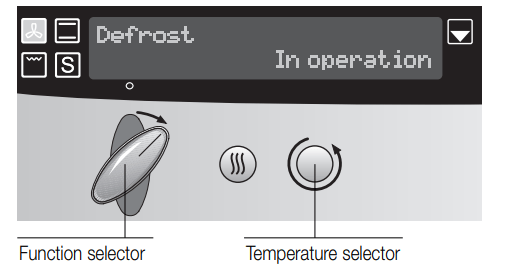
Switching ON
- Rotate the function selector until CircoTherm hot air is displayed.
- Reduce the oven temperature with the temperature selector until Defrost – In operation appears on the text display. The fan at the oven wall runs without heat being generated.
- The Defrost process is now regulated automatically.
Depending on size and type of bakeware, defrost for 25 – 45 minutes. After this time, remove the pastry from the oven. Let stand at room temperature for 30 – 40 minutes.
With smaller amounts (pastries) the defrosting time is reduced to 15 – 20 minutes and the subsequent standing time to 10 – 15 minutes.
Switching OFF
Turn the function selector to the 0 position. All functions are deleted.
Steam cooking – only the main oven
Attention
Can be operated with the system steam accessory only (Available as an optional accessory from specialist outlet).
Do not use the steam cooking setting until the oven has cooled down completely (room temperature).
Select only steam cooking mode for the operating mode. Other settings are not permitted.
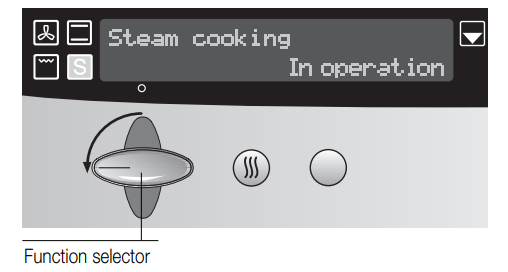
- Turn the function selector until Steam cooking appears on the text display. After approx. 3 seconds Steam cooking setting
– In operation is indicated on the text display. - The steam cooking process is now regulated automatically
Note
When Steam cooking flashes on the text display, the oven has not cooled down completely.
Switch the oven off. Wait until the oven has cooled down to room temperature. Restart the steam cooking setting.
For further information see the operating instructions for the Neff-System steamer.
Dough proving – only the main oven
Warning
Never pour cold water into the oven while it is still hot.
Do not use the dough proving until the oven has cooled down completely (room temperature).
Use normal tap water only, not distilled water.
When making yoghurt, do not put any water in the oven.
Switching ON
- Carefully pour 50 millilitres of water (1 /4 glass) onto the floor of the oven cavity.
- Place the bowl containing the dough onto the middle of a wire shelf inserted at level 1. Do not cover the dough.
- Close the oven door.
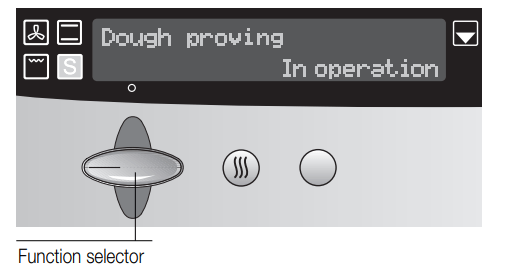
- Turn the function selector until Dough proving appears on the text display. After approx. 3 seconds Dough proving – In operation is displayed. The dough proving process is now controlled automatically.
Note
When Dough proving flashes on the text display, the oven is too hot.
Switch the oven off.
Wait until the oven has cooled down to room temperature.
Restart the dough proving.

Important
The details given in the table above are average values. They can vary according to the type and amount of dough, as well as the condition of the ingredients, e.g. age and quality of the yeast. Please read the enclosed cookery book for suggestions on how to make subsequent use of the dough.
Switching OFF
Turn the function selector to the 0 position.
Before you start baking, remove the water left inside the oven. If any traces of lime are left behind, they can be dissolved with a little vinegar and wiped off using clear water.
Cleaning and Care
Important cleaning basics
For cleaning, do not use abrasives, no corrosive cleaners, and no sharp objects.
Do not scratch off burnt-in food residues, but soak them off with a moist cloth and dishwashing detergent.
Cleaning products we particularly recommend can be purchased from our customer service.
Appliance exterior
Stainless steel/ aluminium front
Use commercially available detergents applied to a soft, moistened cloth or a chamois.
Do not use aggressive cleaning agents, abrasive sponges, or coarse cleaning cloths.
On heavy soiling use commercial cleaning agents on matted stainless steel/aluminium surfaces. Please observe the manufacturer’s instructions.
Enamel and glass
Use commercially available detergents applied to a soft, moistened cloth or a chamois.
Oven door panel
The temperature of the pane inside the oven door is reduced by a heat-reflecting coating.
The reduced temperature ensures that visibility through the oven door window is not impaired.
When the oven door is open, this coating may have a bright appearance. This is quite normal and does not indicate a quality defect.
Oven interior
Clean the oven after each use, especially after roasting or grilling.
Food remnants burn in when the oven is reheated. The baked in remnants are very difficult to remove once burnt in.
Note:
To prevent soiling use:
- CircoTherm hot air. The CircoTherm hot air mode causes less soiling than the others.
- the universal pan to bake very moist cakes.
- suitable utensils (frying pan) for frying.
For easier cleaning
you can switch on the oven lamp and take off the oven door.
For cleaning the mating surface of the oven door at the front of the oven, the door should be removed.
Enamel areas in the oven
Use hot soapy water or a vinegar solution.
It is best to use oven cleaner if the oven is very dirty. Only use oven cleaner in a cold oven.
We recommend cleaning gels because these can be applied with greater precision.
Do not clean the warm oven with any of the cleaning products specifically designed for this purpose.
Leave the oven open so that it can dry after cleaning.
Note:
Enamel is baked on at very high temperatures. This can cause some slight colour variation. This is normal and does not affect the function. Do not use coarse scouring pads or strong cleaning agents to remove such discolorations.
The edges of thin trays cannot be completely enamelled. As a result, these edges can be rough. Anti-corrosion protection is guaranteed.
Catalytic oven surfaces
Cleaning the catalytic surfaces of the oven
The rear wall, the oven ceiling and the side walls of the oven are coated with self-cleaning enamel. The surface cleans itself while the oven is in operation. Large splashes sometimes only disappear after the oven has been used several times.
Never use oven cleaner on catalytic surfaces of the oven.
Should the enamel become slightly stained, this will not affect its self-cleaning properties.
Oven Cleaning
Automatic oven cleaning
Oven cleaning is a regeneration programme. If the self-cleaning panels in the oven are no longer adequately cleaned during normal day-to-day operation, they will be regenerated with this function. They will then be fully functional again.
Take the accessories and utensils out of the oven.
Before switching on automatic oven cleaning, thoroughly clean the areas of the oven that do not have self cleaning panels, e.g. enamelled areas such as the oven floor, inner door. This will prevent residue from burning in.
You can select the duration of automatic oven cleaning via the electronic clock.
The oven becomes very hot during automatic oven cleaning – always keep children away
Setting procedure
Main and Mini oven
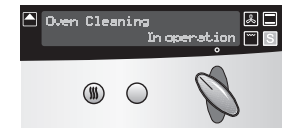
- Rotate the function selector until Oven Cleaning is text displayed. The indicator light
 comes on and In operation is text displayed. The oven heats for 1 hour at 270° C. When Oven Cleaning is complete, a signal sounds, and finished is displayed.
comes on and In operation is text displayed. The oven heats for 1 hour at 270° C. When Oven Cleaning is complete, a signal sounds, and finished is displayed. - Rotate the temperature selector and the function selector to 0.
Switching off oven cleaning
The oven is cooled by the fan which continues running.
Removing/installing the oven door
Oven door
Note: To make the manual cleaning steps following the automatic oven cleaning function more convenient, the appliance features the following options.
Removing the oven door
- Fully open the oven door.
- Move the catch levers on the right and left-hand sides to the fully open position.

- Placing the door at an upward angle toward you, grasp the door with both hands and lift it out of the hinges toward you.
When pulling the door out, make sure that you do not reach into the hinge. There is a risk of injury

Hanging the oven door
- Set both hinges into their respective receptacles on the left and right, and swing the oven door downward.
- Close the catch levers on the left and right.
- Close the oven door.
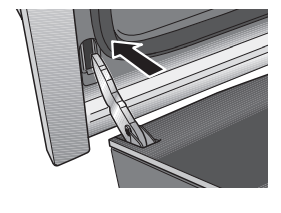
Shelf support
Removing
- Pull the shelf support out of its bearing bush.
- Remove the shelf support.
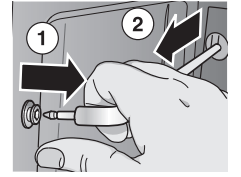
Clean the shelf support using washing-up liquid and pan scrapers or brushes.
Attaching
After cleaning, re-install the shelf support, following the instructions in reverse order.
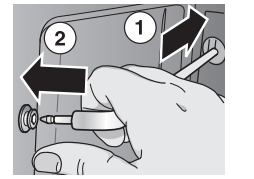
Telescopic pull-outs
Removing
- Press the coach spring down.
- Push the telescope upwards and remove it.
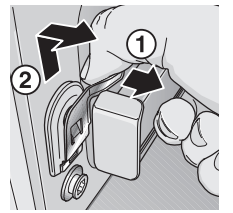
Clean the telescopic pull-outs using washing-up liquid and pan scrapers or brushes.
Attaching
Insert the telescopic pull-out at the rear.
Insert the telescopic pull-out into the guide and press down until it locks into position.
Always insert the telescopic pull-outs all the way.
Do not close the oven door until all telescopic pull-outs have been inserted.
Attention: The telescopic pull-outs become hot when the oven is on. Risk of burns when the telescopic pull-outs are pulled out.
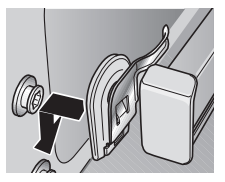
Note Mini oven
Only 1 pair of telescopic rails may be installed in the mini oven ( shelf position 1 or 2 ).
Replacing the oven light
Caution: Unplug the appliance or remove the fuse! By actuating the miniature circuit-breaker or by unscrewing the fuses in the fuse box in your house.
- To prevent damage, place a towel into the cold oven.
- Unscrew the lamp cover by turning it counter-clockwise.
- Replace the lamp.
– Type: Incandescent bulb E 14, 220– 240 V, 40 W, heat-resistant to 300° C
– You may obtain this bulb from your customer service or from your appliance dealer.
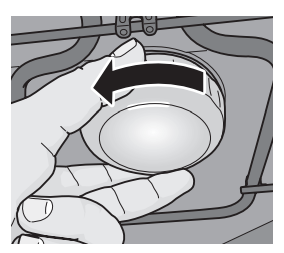
Replacing the oven door seat
Remove the defective oven door seal by simply unhooking it.
You may obtain the new oven door seal from your customer service.
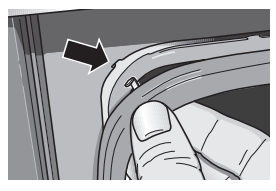
Replacing the halogen bulb for NeffLight
Replacement bulbs and auxiliary tool are available from customer service.
Only a technician may work on the appliance electronics.
Before starting such work, isolate the appliance: By actuating the automatic circuit breakers or unscrewing the fuses in the fuse box in your house.
Before replacing the halogen bulb, detach the oven door.
Halogen bulbs become very hot when switched on. Even some time after they have been switched off, there is a risk of burns.
- Take the auxiliary tool, insert it into the slot and prise out the cover.
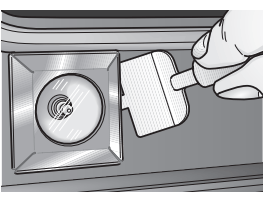
- Pull out the halogen bulb with the other auxiliary tool.
- Replace the halogen bulb,
Attention: Bulb holder.
Take hold of the halogen bulb with a clean cloth.
– Halogen bulb type G4, 12 volts, 20 watts, heat-resistant up to 300 °C.
– Halogen bulbs are available from customer service.
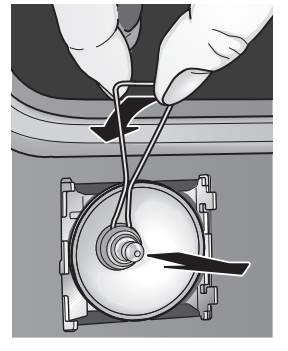
Note
If the light does not function, check whether the bulbs have been inserted correctly.
Trouble-shooting Guide
Calling the customer service is not always really necessary. In some cases, you can remedy the situation yourself. The following table may contain some helpful tips.
Important general safety guidelines:
Service or repair work on the electronic components may only be performed by a qualified expert. Without exception, prior to starting such repairs, the appliance must be disconnected from the mains. This may be accomplished by tripping the automatic fuse or by removing the fuse from the fuse box that controls your flat or apartment.
| Problem | Possible cause | Remedy |
| . . . if there is a general failure of all electrical functions, i.e., the control lamps have suddenly ceased to function. | Defective fuse | Check the fuse in the fuse box, and replace if required. |
| . . . if liquids or thin viscous dough are distributed at a visibly uneven thickness? | The appliance has not been placed or installed plumb-and-level. | Level the appliance using the leveling feet, or check the installation. |
| . . . if the oven suddenly stop functioning? | The electronic clock is set to an automatic timing cycle. |
Set electronic clock to operation without automatic timer:
|
| . . . if the oven suddenly stop functioning? | Automatic timer switched OFF oven. | Set electronic clock to operationwithout automatic timer: Press the  button. button. |
| . . . if the oven suddenly stop functioning and the electronic clock flashes 0:00? | The power supply was briefly interrupted. | Reset the time of day |
| . . . if rrris displayed? | The power supply was briefly interrupted. | Re-activate the electronic clock and oven control. |
| . . . if a foreign language is indicated on the display. | Wrong operating language set or the power supply was briefly interrupted. | Select new language see (”Language for the text display”). |
| . . . when Controls locked appears on the display? | The oven is locked (child safety). | Turn the function selector anticlockwise from 0 to Oven lighting and back again three times. Control locked disappears. |
| . . . when Permanent lock appears on the display? | The oven is locked (child safety). | Turn the function selector anticlockwise from 0 to Oven lighting and back again six times. Permanent lock disappears. |
| . . . when the symbols on the control panel light up, but the oven does not heat up? | The oven has been The oven has been unauthorised use (demo mode). |
Turn the function selector from Large grill to Small grill and back again five times. ❑ Demo OFF must appear on the display |
| . . . if electronically control functions fail? | Energy pulses (e.g. lightning flash). | Reset the relevant functions. |
| . . . when the indicator lamp for oven functions does not light up red when cleaning (main oven) or dough proving mode is switched ON? | Temperature inside oven cavity is still too high. | Prior to using the oven cleaning function, the oven must be allowed to cool completely. |
| Defective control lamp | Replacement only by an authorised expert. | |
| . . . if the telescopic extension rails can no longer be pushed in all the way? | Bearing misalignment after cleaning | Initially, pull out the telescopic extension rails all the way. |
| . . . if smoke is generated during roasting or grilling? | Roasting temperature to high. | |
| Wire shelf or universal pan slid in incorrectly. | Place wire shelf into universal pan and insert together in shelf position. | |
| . . . if enamelled slide-in parts show mat bright stains? | Normal occurrence due to dripping meat juices. | Not available. |
| . . . if the glass pane or window of the oven door become clouded? | Normal occurrence, due to existing temperature difference. | Switch on the oven for app. 5 minutes at 100° C. |
| . . . if the oven shows increasing condensation water? | Normal occurrence, e.g. in the case of cakes with very moist topping (fruit) or roasts. | Briefly open the oven door occasionally during baking or roasting, wipe up the condensation water after operation. |
| . . . if the panes of the oven door are dirty on the inside after some time of use? | Normal soiling |
Remove the oven door and place it facing down on a clean and soft surface. Take hold of the door glass next to the hinges, disengage and raise slightly. Remove the door glass towards the hinges.
Lift and disengage inner door glass, e.g. using a spatula, on one side and then lift and disengage on the other side.
Attention! The light duct must not be cleaned as it is very sensitive to scratches. Installation after cleaning: Insert inner door glass into the holder. First engage the right side and then the other side.
Hang door glass and press down next to the hinges until it clicks into place. |
 button.
button. to 0:00.
to 0:00.